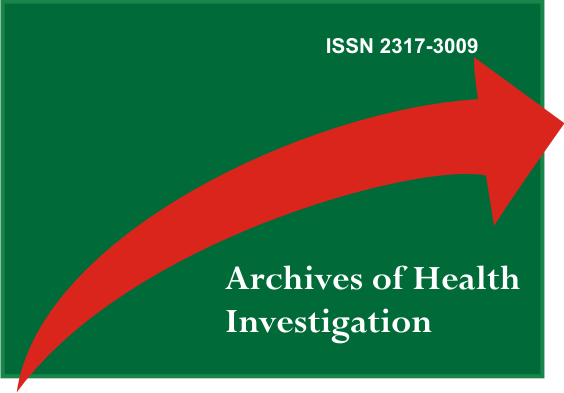Regeneração endodôntica em dente permanente jovem portador de necrose pulpar e rizogênese incompleta: relato de caso clínico
DOI:
https://doi.org/10.21270/archi.v6i7.2082Abstract
A terapia endodôntica de dentes com morte pulpar e rizogênese incompleta é complexa representando um desafio aos endodontistas, exigindo muita habilidade profissional. E para esses casos, uma alternativa promissora vem sendo muito utilizada, conhecida como regeneração ou revascularização pulpar. Esta técnica é menos invasiva quando comparada a técnica tradicional (apicificação), sendo que na revascularização pulpar por meio de um estímulo ocorre a invaginação de um novo tecido para o interior do canal, permitindo assim a regeneração dos tecidos danificados, devolvendo suas condições fisiológicas de vitalidade. O objetivo deste trabalho será descrever um tratamento de revascularização em um dente permanente jovem com ápice aberto que sofreu necrose pulpar após a ocorrência de um trauma. Conclusão: De acordo com os resultados obtidos; concluímos que houve regressão completa de sintomatologias, involução da fístula sem recidiva, resposta positiva ao teste de vitalidade pulpar, além do contínuo desenvolvimento radicular e regeneração do tecido danificado, comprovando assim a efetividade da técnica.Descritores: Raiz Dentária; Necrose da Polpa Dentária; Hidróxido de Cálcio; Regeneração.
Downloads
References
Kusgoz A, Yldirrin T, Er k, Arslan I. Retreatment of a resected thoot associated whit a large perriapical lesion by using a triple antibiotic past and MTA: a case reported. JOE 2009; 35(11)1603-06.
Souza TS, Deonízio MA, Batista A, Kowalczuck A, Sydney GB. Regeneração endodôntica: existe um protocolo? Rev Odontol Bras Central. 2013; 22(63):128-33.
Lovelace TW, Henry MA, Hargreaves KM, Diogenes A. Evaluation of the delivery of mesenchymal stem cells into the root canal space of necrotic immature teeth after clinical regenerative endodontic procedure. J Endod. 2011; 37(2):133-138.
Machado MEL, Haddad Filho MG, Aguiar CM. Endodontia - tópicos da atualidade. Nova Odessa: Napoleão Editora; 2015, p.346-73.
Lopes HP, Siqueira Jr JF. Endodontia - Biologia e Técnica. 4.ed. Rio de Janeiro: Elsevier – Campus; 2015, p. 760-773.
Jung IY, Lee SJ, Hargreaves KM. Biologically base treatment of immature teeth with pupal necrosis: a case series. J Endod. 2008; 34(7):876-87.
Hargreaves KM, Geisler T, Henry M, Wang Y. Regeneration potencial of the young permanent tooth: what does the future hold? J Endod. 2008; 34(37):51-56.
Alcade MP, Guimarães BM, Fernandes SL, Silva PAA, Bramante CM, Vivan RR, et al. Revascularização pulpar: considerações técnicas e implicações clínicas. Salusvita. 2014; 33(3):415-432.
Trevino EG, Patwardhand AN, Henry MA. Effects of irrigants on the survival of human stem cells of the apical papilla in a platelet-rich plasma scaffold in human root tips. J Endod. 2011; 37(8):1109-15.
Nagata JY, Gomes BP, Rocha Lima TF, Murakami LS, de Faria DE, Campos GR et al. Traumatized immature teeth treated with 2 protocols of pulp resvacularization. J Endod. 2014; 40(5):606-12.
Nosrat A, Seifi A, Asgary S. Regenerative endodontic treatment (revascularization) for necrotic immature permanent molars: a review and report of two cases with a new biomaterial. J Endod. 2011; 37(4): 562-7.
Shin SY, Albert JS, Mortman RE. One step pulp revascularization treatment of a immature permanent tooth with chronic apical abcess: a case report. Int Endod J. 2009;42(12):1118-26.
Reynolds K, Johnson JD, Cohenca N. Pulp revascularization of necrotic bilateral bicuspids using a modified novel technique to eliminate potential coronal discoloration: a case report. Int Endod J. 2009; 42(1):84-92.
Galler KM, D’Souza RN, Federlin M, Cavender AC, Hartgerink JD, Hecker S. Dentin conditioning codetermines cell fate in regenerative endodontics. J Endod. 2011; 37(11):1536-41.
Graham L, Cooper PR, Cassidy N, Nor JE, Sloan AJ, Smith AJ. The effect of calcium hydroxide on solubilization of bio-active dentine matrix components. Biomaterials. 2006; 27(14):2865-73.
Turkistani J, Hanna A. Recent trends in the management of dento alveolar traumatic injuries to primary and young permanent teeth. Dent Traumatol. 2011; 27(1):46-54.
Iwaya SI, Ikawa M, Kubota M. Revascularization of an immature permanent tooth with periradicular abscess after luxation. Dent Traumatol. 2011; 27(1):55-8
Bose R, Nummikoski P, Hargreaves K. A retrospective evaluation of radiographic outcomes in immature teeth with necrotic root canal systems treated with regenerative endodontic procedures. J Endod. 2009; 35(10):1343-9.
Dhillon H, Kaushik M, Sharma R. Regenerative endodontics-Creatinh new horizons. J Biomed Mater Res B Appl Biomater. 2016 :104(4):676-85.
Bansal R, Bansal R. Regenerative endodontics: a state of the art. Indian J Dent Res. 2011; 22(1):122-31.
Souza Filho FJ. Tratamento de dentes com rizogênese incompleta: revitalização ou apicificação. In: Endodontia passo a passo: evidências clínicas. São Paulo: Artes Médicas; 2015, p.166-175.
Ding RY, Cheung GS, Chen J, Yin XZ, Wang Q, Zhang C. Pulp revascularization of immature teeth with apical periodontitis: a clinical study. J Endod. 2009; 35(5):745-9.
Sarris S, Tahmassebi JF, Duggal MS, Cross IA. A clinical evaluation of mineral trioxide aggregate for root-end closure of non-vital immature permanent incisors in children-a pilot study. Dent Traumatol. 2008; 24(1):79-85.
Pradhan DP, Chawla HS, Gauba K, Goyal A. Comparative evaluation of endodontic management of teeth with unformed apices with mineral trioxide aggregate and calcium hydroxide. J Dent Child (Chic). 2006; 73(2):79-85.
Porter ML, Bertó A, Primus CM, Watanabe I. Physical and chemical properties of new-generation endodontic materials. J Endod. 2010; 36(3):524-8.
Chen MY, Chen KL, Chen CA, Tayebaty F, Rosenberg PA, Lin LM. Responses of immature permanent teeth with infected necrotic pulp tissue and apical periodontitis/abscess to revascularization procedures. Int Endod J. 2012;45(3):294-305.
Chueh LH, Ho YC, Kuo TC, Lai WH, Chen YH, Chiang CP. Regenerative endodontic treatment for necrotic immature permanent teeth. J Endod. 2009;35(2):160-4.


